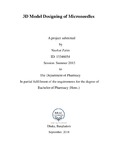| dc.contributor.advisor | Kabir, Eva Rahman | |
| dc.contributor.author | Zahin, Nuzhat | |
| dc.date.accessioned | 2018-10-22T09:34:16Z | |
| dc.date.available | 2018-10-22T09:34:16Z | |
| dc.date.copyright | 2018 | |
| dc.date.issued | 2018-09 | |
| dc.identifier.other | ID 13346054 | |
| dc.identifier.uri | http://hdl.handle.net/10361/10742 | |
| dc.description | This project report is submitted in partial fulfilment of the requirements for the degree of Bachelor of Pharmacy, 2018. | en_US |
| dc.description | Catalogued from PDF version of project report. | |
| dc.description | Includes bibliographical references (page 25-30). | |
| dc.description.abstract | The rising demand and resulting success of transdermal products over the last three decades have seen the expanding path for 3D printed microneedles. The benefits of the application of transdermal drugs via 3D printed microneedle are emerging day by day. A microneedle is a three-dimensional (3D) micromechanical structure that breaches the stratum corneum of the skin to create micro channels for passing active ingredients of the drug by transdermal drug delivery system. 3D printing (additive manufacturing) is a process of making three dimensional solid objects from a digital file. It involves a family of diverse technologies that employ a virtual model to formulate a physical object via numerically controlled apparatuses. Various methods and software can be used to fabricate a 3D printed microneedle. For instance, a 3D designing software can be used to design the microneedles by providing appropriate information and data. The present study involves the use of the software where, twelve microneedles were designed using different 3D shapes and sizes and then one was chosen for 3D printing after taking several corrective measures and analyzing the required specifications. The final chosen microneedle model was printed using the 3D printer that contained high resolution capabilities. Therefore, this paper aims to explain an overview of the designing properties and methods for a 3D printed microneedle, and its uses and advantages in pharmaceutical application. Future work will involve investigation of the use of 3D printed microneedle in the transdermal delivery of drugs among patients in Bangladesh. | en_US |
| dc.description.statementofresponsibility | Nuzhat Zahin | |
| dc.format.extent | 30 pages | |
| dc.language.iso | en | en_US |
| dc.publisher | BRAC University | en_US |
| dc.rights | BRAC University project reports are protected by copyright. They may be viewed from this source for any purpose, but reproduction or distribution in any format is prohibited without written permission. | |
| dc.subject | 3D model design | en_US |
| dc.subject | Microneedles | en_US |
| dc.subject.lcsh | Image processing | |
| dc.title | 3D model designing of microneedles | en_US |
| dc.type | Project report | en_US |
| dc.contributor.department | Department of Pharmacy, BRAC University | |
| dc.description.degree | B. Pharmacy | |

